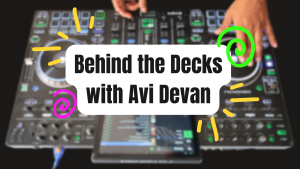Hidden Difficulties
People with health conditions often face difficulties that others do not notice.
A TV screen shows a screen with text that says “NO SIGNAL.”
December 12, 2018
Joshua Janni ’25 is deaf and often experiences problems that other people do not even think about. Unfortunately, this oversight can exclude many individuals or even harm them. Being aware of these difficulties is critical for everyone and especially for movie theaters and other companies that serve the public.
For his Family Consumer Science class, Janni was assigned to watch an informational video. “The teacher had put it together, like it was not online… he was watching it and was supposed to take notes on it,” his sister, Anna Janni ’20, said. “He was getting frustrated because there were no captions. It was a cooking video so it would switch between showing the teacher and showing the food that she was making. That was also hard, because he couldn’t even see her lips, so lip-reading wasn’t an option.”
These types of oversights are not exclusive to the deaf community. Movies and TV screens also have the potential to trigger a seizure for epileptic viewers.
Most people can go to the movies without any issues, this is not true for everyone. People with certain types of epilepsy have to carefully research movies in order to lessen the risk of a seizure. “Epilepsy is a condition where individuals are more likely to have seizures than the rest of the population,” epilepsy expert Gena R. Ghearing said in an email interview. “…photosensitive epilepsy [is] when seizures are brought on by a light stimulus. The most common trigger is flickering lights, which can occur with strobe lights, video games, television shows, or fluorescent lights. There are also natural sources such as the sun flashing through leaves as you drive by trees.”
Alexis Gorsh ’21 has a specific type of epilepsy that falls under the umbrella of photosensitive epilepsy, called Juvenile Myoclonic Epilepsy. “…the movie “Incredibles 2″ had some seizure warnings and I really wanted to see it,” Gorsh said. “But I couldn’t because I don’t want anything to happen.” A short scene in the movie made it so Gorsh could not see the whole movie. “[I’m] honestly pretty upset!” Gorsh said. “The first “Incredibles” movie is like one of my favorites! It’s a classic! So the fact that I went to the movie theater to go see it because I didn’t know. [The epilepsy warning] wasn’t advertised anywhere else and when I was in the movie and there was something on the screen saying ‘digression for epilepsy.’ Then I had to leave because I didn’t want to put myself in that situation.” Gorsh was able to get a refund for her ticket, but she shouldn’t have needed to get one in the first place.
TV shows can be culprits of triggering epilepsy as well. December 16, 1997, has the best documented case of a television show causing seizures. Over 600 children in Japan were hospitalized after watching a rocket launch sequence in a Pokémon episode. Since then movie creators have become more aware of the dangers. They do try and prevent seizures caused by television screens. However they are not as diligent in providing warnings for the epileptic community.
Movie theaters fail to accommodate the deaf community as well. Captions are necessary for many in the deaf community to understand a movie. However, movie theaters often do not show captions on the big screen. Instead they provide caption reading devices for those in need of captions, but these devices frequently have issues. “… every time we get a caption device, it either does not work at the beginning of the movie, or it’s out of battery, or something,” Anna Janni said. “So there are multiple trips back to staff, saying, ‘Hey, can you get us the captioning?’ And when it does work, I think it can be used to help a deaf person understand, but I do think it’s a nuisance because it’s not displayed in the same place. So they’re switching back and forth between what’s said and what’s seen.”
Movie producers and theaters have an obligation to the deaf and epileptic communities to fix these problems. People with epilepsy and those who are deaf cannot do anything about their conditions, but movie creators can do something about it and they need to. There are 100,000 Americans with photosensitive epilepsy and 37.5 million Americans with hearing problems. This is just in the United States. Think about how many people cannot see the movies they are passionate about because the people in charge will not make simple accommodations for them.
It is not that people with epilepsy just feel sick when they have a seizure, the effects can be scary. “Seizures are abnormal electrical activity from the cortex of the brain, which can cause muscles to jerk (myoclonic seizures), someone to stop what they are doing and stare (absence seizures), or have stiffening of the body with jerking of the arms and legs (generalized tonic-clonic seizures),” Ghearing said. “Seizures commonly cause injuries, such as concussions from falls, but also can lead to death.”
Given that scenes that affect people with epilepsy often are not critical for movie development, it seems cruel to include them considering the substantial health risks. At the very least, flashing lights can easily be taken out of movies as to not trigger a seizure. There are so many other cinematic effects that can create an aesthetic scene, that are less of a risk for epileptic viewers. Education is big part of helping the epileptic community. People need to learn how they can help and then help them. Movie creators need to be aware of risky techniques and learn what they can include instead.
Movie companies already create captions for the DVD versions of their movies. What would be the big deal of showing the movie two or three times in theaters with captions? It would not cause any extra work for the producers or the theater even. Some people would argue that tickets would not sell for captioned movies, but look at the sheer numbers of Americans with hearing issues. Not to mention all the people who prefer to have captions for their movies. “It’s not unusual to see someone asking for a closed captioning device,” a theater employee, Megan Jones ’21 said. Or if the people that need captions are not a large enough audience, theaters could offer tickets to captioned movies for a slightly cheaper price. It would dramatically raise attendance and raise ticket sales for those movies. More importantly, it would give ease of access to the entire community of people that have hearing problems.
In the end society needs to take more steps to make movies available to everyone. “I think that efforts are made, but it’s puzzling because I don’t think it would be that difficult to go that next step to make things more accessible for the deaf, hard of hearing, epileptic, whatever it may be,” Anna Janni said. “I really think it’s crazy. That’s the thing we fight for and we encourage Joshua to advocate for himself in instances like that.”





